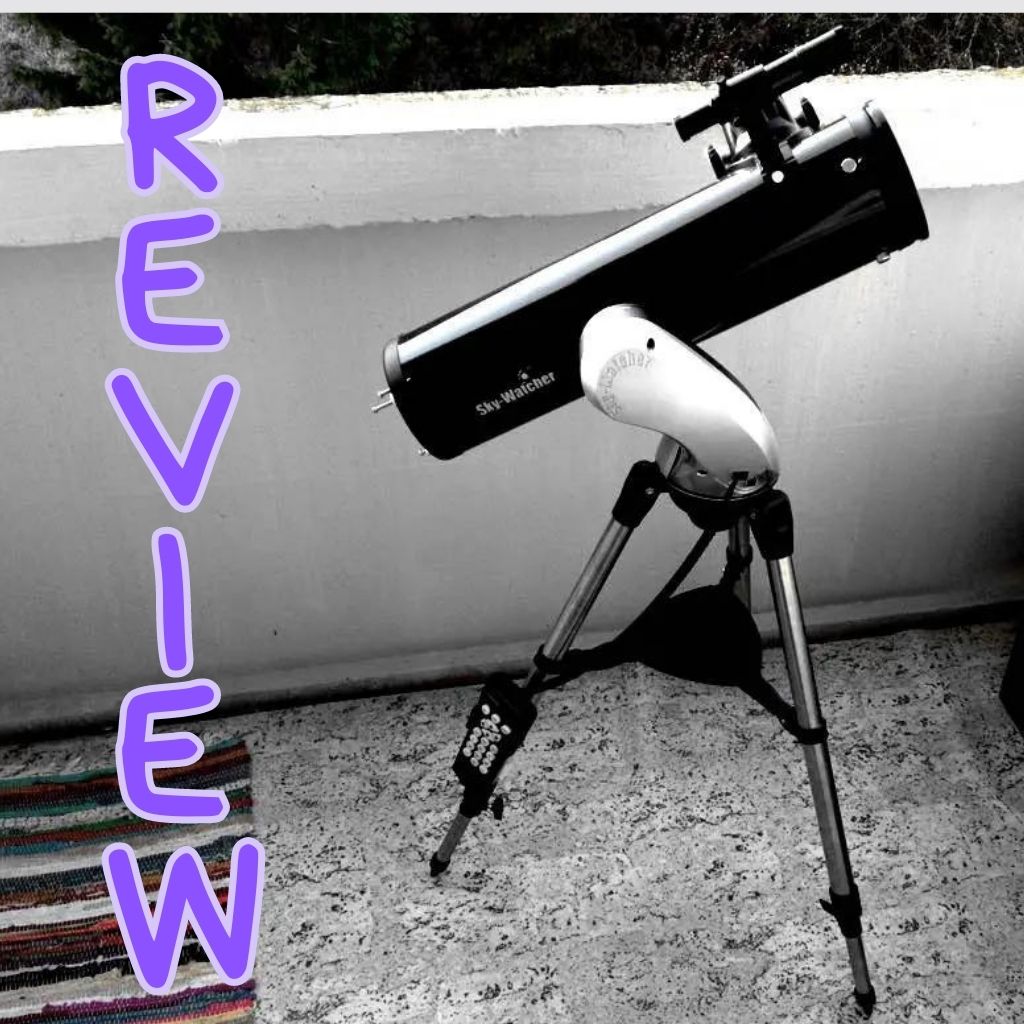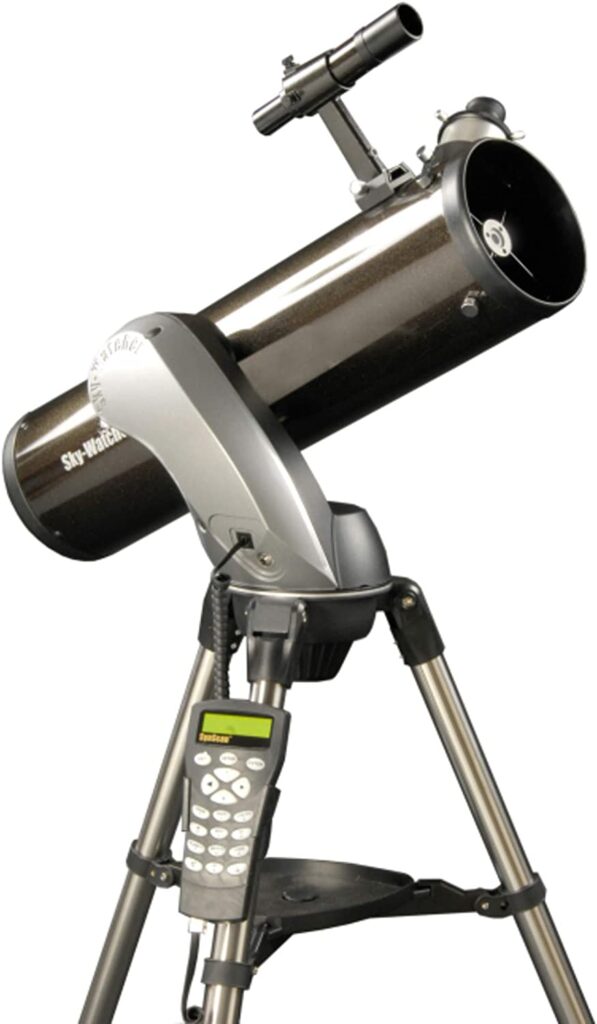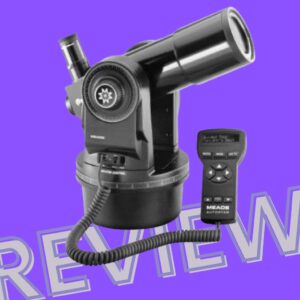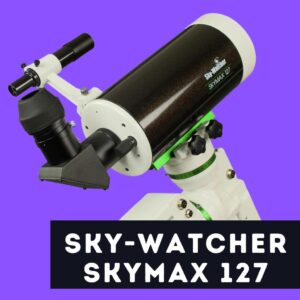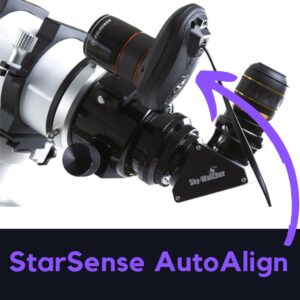This site contains affiliate links to products. I may receive a commission for purchases made through these links.
The Sky-Watcher Explorer 130P SynScan AZ GoTo telescope stands out as a versatile parabolic Newtonian reflector. With its large f/5 aperture, it serves as an all-rounder, delivering exceptional images suitable for both visual astronomy and astrophotography. Its user-friendly nature is further enhanced by the SynScan app, which simplifies the process of locating celestial objects, making it an ideal choice for beginners.
For those in search of a telescope that excels in various aspects of stargazing and astrophotography, the Sky-Watcher Explorer 130P SynScan AZ GoTo emerges as a top contender. Its combination of portability and performance has made it a favorite among astronomy enthusiasts, leading some to choose it repeatedly for their observational needs.
This article dives deep into the features of the Sky-Watcher Explorer 130P SynScan AZ GoTo telescope, discussing its specifications, ease of use, and other notable attributes.
Specifications of the Sky-Watcher Explorer 130P
The powerful Sky-Watcher Explorer 130P telescope comes with the following features:
Optical tube assembly of the Sky-Watcher Explorer 130P
The Sky-Watcher Explorer 130P telescope features a Newtonian reflector design with a sleek, black 130mm aperture optical tube assembly, enhanced by a sparkling silver finish.
Its F/5 configuration provides bright images and a wide field of view, making it well-suited for deep-sky observations, although it’s also capable of planetary viewing with the right magnification. The telescope’s standout feature is its parabolic primary mirror, which eliminates spherical aberrations for sharper, higher-contrast images.
Additionally, its 130mm aperture offers 30% more light-gathering power than 114mm scopes, ensuring better visibility of faint celestial objects.
You may also like: Refractor vs Reflector Telescope (What Is The Difference)
Rack and pinion focuser of the Sky-Watcher Explorer 130P telescope
The focuser of the Sky-Watcher Explorer 130P telescope stands out for its superior quality in its price range. This telescope is equipped with a versatile 2” rack & pinion focuser, which includes a 1.25” adaptor, allowing the use of both 2″ and 1.25″ equipment. This feature is particularly beneficial for astrophotography, especially when using a DSLR camera.
The focuser’s larger adjusting wheels facilitate finer focus adjustments compared to standard focusers. While they may not offer the precision of a dual-speed focuser, they are sufficiently close, providing an enhanced focusing experience. These wheels are constructed from aluminum and are covered with rubber for improved grip.
Additionally, the focuser includes a useful focus lock — a locking screw that maintains the perfect focus throughout an observation session, which is especially handy when using a heavy camera, ensuring it stays precisely focused without slipping.
Finderscope of the Sky-Watcher Explorer 130P
The Sky-Watcher Explorer 130P features a 6×30 finderscope, mounted on a durable metal base, which acts as a mini telescope with a crosshair to assist in locating celestial objects.
To ensure accuracy, it’s important to align the finderscope with the Optical Tube Assembly (OTA). This alignment is best done during the day by targeting a terrestrial object like a tree or street lamp and adjusting the finderscope mount screws until the object is centered in both the finderscope and OTA.
While the telescope’s Synscan tracking system aids in locating objects, the finderscope’s crosshair and wider field of view become particularly helpful for pinpointing and centering objects, especially when using high magnification. This is a notable advantage over telescopes that use a red dot finder, as many users, especially beginners, find the crosshair of a finderscope more intuitive and easier to use.
The inclusion of the finderscope with the Sky-Watcher Explorer 130P significantly enhances the ease of locating and centering objects in the eyepiece, adding to the overall user-friendly experience of this telescope.
SynScan GoTo mount and tripod of the Sky-Watcher Explorer 130P
Synscan GoTo mount is a motorized type of mount. It has two motors that move the telescope in altazimuth directions (up-down and left-right).
You can control the mount with the Synscan handset, which contains almost 43,000 objects you can point the telescope at.
After the initial star alignment, the mount will point the telescope anywhere you want in the sky. Its slow-motion control cables allow you to easily track objects as they move across the night sky.
It’ll follow the apparent movement of your target, keeping it in the middle of the view.
The telescope comes with a small handbag for AA batteries that can power the mount when you are in the field without the power outlet. However, you may want to buy an additional 12v DC Power Supply to power the mount.
The power supply is not included in the package, and you have to buy it separately if you want. You should buy one because the tracking is better with a power supply, and you don’t have to worry about going out of juice in the middle of the night.
The Celestron PowerTank Portable 12V Power Supply for computerized telescopes will give you 10 hours of uninterrupted viewing. The mount head sits on a tripod, which is another thing you’ll love about the Sky-Watcher Explorer 130P telescope.
Many low-cost telescopes come with an aluminum legs tripod, which wobbles when you touch the scope or try to focus. However, the Explorer 130P’s tripod has sturdy stainless steel legs. It handles the load of the telescope and the mount pretty well. And, of course, it looks much better.
SynScan AZ GoTo Mount features
- SynScan™ Database: Total 42,900+ Objects, including Complete M, NGC, IC & SAO Catalogues
- Alignment Method: Two-star or Brightest star alignment
- Pointing Accuracy: up to 10 arcmin
- Tracking Rates: Sidereal, Lunar, Solar
- Slewing Speeds: 1.0x, 2.0x, 16x, 32x, 64x, 128x, 400x, 500x, 600x, 800x
- Tracking Mode: Dual Axis Tracking
- Motor Type & Resolution: DC Servo Motors. Resolution 0.8923 arcsec or 1,452,425 steps/rev
- PC Compatibility: can be used with popular Planetarium Software.
- SynScan Handset: Firmware upgradeable via the Internet
- Power Requirement: 12v DC Power Supply (Tip Positive) or AA Batteries (not supplied)
Eyepieces of the Sky-Watcher Explorer 130P
The Sky-Watcher Explorer 130P is equipped with two 1.25″ Plossl eyepieces and a 2x Barlow lens, enhancing its viewing capabilities. The eyepieces include a 25mm for wide-field, deep-sky viewing and a 10mm ideal for planetary observations. The versatility is further increased with the 2x Barlow lens, which doubles the magnification.
Additionally, the Barlow lens has a unique feature where its lens element can be unscrewed and attached directly to the eyepieces, offering 1.5x magnification. This effectively provides six different focal lengths when combined with the two eyepieces. The telescope’s focuser accommodates 2″ eyepieces as well, allowing for an expanded eyepiece collection for broader viewing options.
Furthermore, the Barlow lens includes an M42 thread for attaching a DSLR camera for astrophotography, although a T-Ring specific to the DSLR is required for connection. This setup enables users to capture images of the moon and planets, adding to the telescope’s overall versatility.
How to assemble and use the Sky-Watcher Explorer 130P
Setting up the Sky-Watcher Explorer 130P telescope is easy and straightforward. The process includes the following:
Mount the tripod
First, place the tripod on an even, solid surface. You need a solid base under the tripod because you don’t want to have any vibrations from walking around.
Also, if it’s on the grass, it can sink in over time and mess up the leveling and alignment. So, put it on the path or concrete where it will be stable. You need to level the tripod when you find a good place for it.
TIP: Don’t use the built-in level tool. Buy your own in the hardware store and use that to level the tripod in all directions. Build-in levels are, in most cases, slightly off, so you would end up with the wrong level and inaccurate star alignment. And that will disrupt your observing session.
Mount the scope
Now, you can screw the mount head onto the tripod and connect the telescope securing the Vixen dovetail on the mount.
Tighten everything up so nothing will fall off the tripod and mount. But be careful not to move the tripod after you properly level it. Now you are ready to start the star alignment.
Be sure to prepare everything while there’s still a little light outside. It’s more convenient. Plus, it means you’ll be ready when it gets dark.
Star alignment
Star alignment with the Sky-Watcher Explorer 130P involves a straightforward process to orient the telescope accurately. Upon powering up the mount, the Synscan controller prompts for essential data like current time, time zone, daylight saving, GPS location, and elevation. Following this, the user selects a star alignment method – either the brightest star alignment or the 2-star alignment, both offering similar tracking accuracy.
For the brightest star alignment, the user picks a visible star from a chosen section of the sky, like the northern or western sky, using the hand controller to point the telescope towards it. A star chart or planetarium software can assist in identifying the selected star. After centering the first star in the eyepiece, the telescope automatically slews to a second star, which the user then centers in the eyepiece. Once both stars are aligned and confirmed, the telescope is ready to locate any desired celestial object.
The telescope includes a comprehensive instruction manual for the SynScan GoTo mount, providing additional guidance and tips for successful star alignment. This manual proves particularly useful for troubleshooting any alignment challenges and ensuring optimal setup.
Focus on the Sky-Watcher Explorer 130P AZ Go-2 SynScan app
The SynScan app is one of the Sky-Watcher Explorer 130P telescope’s main features, which makes it beginner-friendly. You can effortlessly control the scope using the SynScan handset.
The SynScan software is bug-free and crash-free. It has a catalog of over 43,000 objects. These include solar system objects like planets and deep-sky objects in the Messier, Caldwell, NGC, and IC catalogs.
With the SynScan app, you can simply hit a button, and the scope will move to point to the sky object you want to observe.
Pros of the Sky-Watcher Explorer 130P
Some advantages of the Sky-Watcher Explorer 130P telescope include:
- High-quality images: With its 130mm aperture, the Explorer 130P gathers 30% more light than the 114mm aperture scopes before it. The scope can produce brighter images, and you can see fainter objects.
- Quality optics: The Explorer 130P features parabolic mirrors normally found in larger, more expensive telescopes. These mirrors eliminate spherical aberrations to produce sharper images.
- Easy to locate objects: The SynScan software makes Explorer 130P beginner-friendly. The software makes locating and tracking objects in the night sky easy.
- Sturdy tripod: The tripods of most telescopes feature aluminum legs. But the tripod of the Explorer 130P features better load-carrying and more durable stainless-steel legs.
- Affordability: For a telescope of its size and quality optics, the Sky-Watcher Explorer 130P is relatively cheap and budget-friendly.
Con of the Sky-Watcher 130P telescope
However, before buying the Explorer 130P, you may want to consider the frequent maintenance. Being a Newtonian reflector, the telescope gets knocked out of alignment pretty easily. This means you’ll need to collimate your telescope all the time.
What can you see with the Sky-Watcher Explorer 130P telescope?
The Sky-Watcher Explorer 130P telescope excels in delivering clear views of the moon, planets, and bright deep-sky objects like star clusters and galaxies. Its 130mm aperture and quality optics allow it to gather ample light for sharp, detailed observations. With an f/5 focal ratio, the telescope achieves high magnifications, enabling users to see intricate details of celestial bodies like the moon’s craters and the rings of Saturn, even in areas with light pollution.
Equipped with a 25mm eyepiece and a Barlow lens, the telescope offers 65x magnification, ideal for observing Jupiter’s moons and Saturn’s rings.
It also performs well in deep-sky astronomy, providing clear views of notable objects such as the Double Cluster in Perseus and Albireo in Cygnus.
This telescope is a versatile instrument for both beginner and experienced astronomers seeking to explore a variety of celestial phenomena.
Can you use the Sky-Watcher Explorer 130P for astrophotography?
The Sky-Watcher Explorer 130P telescope is suitable for astrophotography, accommodating both planetary and deep-sky imaging. Planetary astrophotography, which typically focuses on the Moon and planets, can be achieved with simple equipment like a webcam. This approach allows for the creation of striking images or videos of these celestial bodies.
While planetary astrophotography is relatively straightforward, deep-sky astrophotography presents more complexity and requires some modifications to the telescope. These adjustments enhance the telescope’s capability to capture detailed images of distant celestial objects like galaxies and nebulae.
For those interested in pursuing deep-sky astrophotography with the Sky-Watcher Explorer 130P, you will have to modify the telescope. Learn how to do it with this exact model here.
Here are examples of deep-sky photos shot with the Sky-Watcher Explorer 130P telescope:
Is the Sky-Watcher 130P a good telescope for beginners?
The Sky-Watcher Explorer 130P is a beginner-friendly telescope as it is easy to set up and features a GoTo functionality that makes it easy to use.
The free SynScan app is intuitive and easy to use. It lets you easily control the telescope and point it at objects in the sky.
Is the Sky-Watcher Explorer 130P telescope a good investment?
The Sky-Watcher Explorer 130P is a good value telescope capable of impressive views of solar system objects, double stars, and bright deep-sky objects.
There are definitely more reasons to invest in the Sky-Watcher Explorer 130P than not.
The scope produces quality images thanks to its increased light-gathering ability and quality optics. Then there’s its superior finderscope and GoTo functionality which makes it easy to use.
There’s also the sturdy tripod and the versatility of doing visual astronomy and some astrophotography.
Lastly, it is an affordable telescope with capabilities that many cheap telescopes lack.
Takeaway: Get fantastic images of the solar system and bright deep sky objects with the Sky-Watcher Explorer 130P
The Sky-Watcher Explorer 130P SynScan AZ GoTo telescope is a great scope for beginners and more seasoned astronomers.
With specs like a 130mm aperture, 650mm focal length, and a parabolic primary mirror, it produces sharp images for a fulfilling stargazing experience. It’s easy to set up and boasts a finderscope and GoTo functionality that make it easy to use.
It’s a great telescope for viewing the moon, planets, and bright deep-sky objects. It’ll also serve you if you want to spice up your stargazing experience with a little astrophotography.
You may also like:

